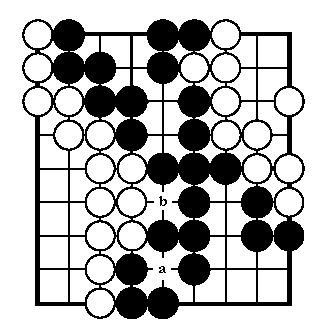Problem A
Deciding victory in Go
The history of Go stretches back some 3000 years
and the rules have remained essentially unchanged throughout this
very long period. The game probably originated in China or the
Himalayas. In the Far East, where it originated, Go enjoys great
popularity today and interest in the game is growing steadily in
Europe and America.
A game of Go starts with an empty square board and each player
has an unlimited supply of stones, one taking the black stones,
the other taking white. The basic object of the game is to use
one’s stones to form territories by surrounding vacant areas
of the board. It is also possible to capture the opponent’s
stones by completely surrounding them. The players take turns,
placing one of their stones on a vacant point at each turn, Black
playing first. Note that the stones are placed on the
intersections of the lines rather than in the squares (there are
no diagonal connections). Once played, stones are not moved
although they may be captured, in which case they are removed
from the board. At the end of the game (when both players pass)
the players count one point for each vacant point inside their
own territory and one point for every stone they have on the
board. Wins the player with the larger total of points.
Problem
Given a certain Go board position; decide the number of points
of each player.
 |
Example
Black has surrounded 15 points of territory: 3 at the
top of the board, 2 points just below, 9 in the lower
right corner plus one point for the territory at
intersection a. Adding the actual stones on board (24
stones), Black has a total of 39 points.White’s
territory is 17 points: 11 on the left sector plus 6 on
the right sector. With 24 stones on board, he has a total
of 41 points. So, White wins the game by two
points.Notice that intersection b does not belong to
either player.
|
Input
The input file will contain one line with one integer defining
the number of board positions. On the following lines the
positions are presented. Each position consists of nine lines of
nine characters: X for black stones, O for white stones and a
‘.’ (a dot) for empty intersections. There is no empty
line separating each problem set.
Output
Correct output consists of a set of lines (one for each
problem solution) where each line consists of: Black <Black
points> White <White points> newline.
Sample Input
1
OX..XXO..
OXX.XOO..
OOXX.XO.O
.OOX.XOO.
..OOXXXOO
..OO.X.XO
..OOXX.XX
..OX.X...
..OXX....
Sample Output
Black 39 White 41
Joćo Neto, MIUP'2002
